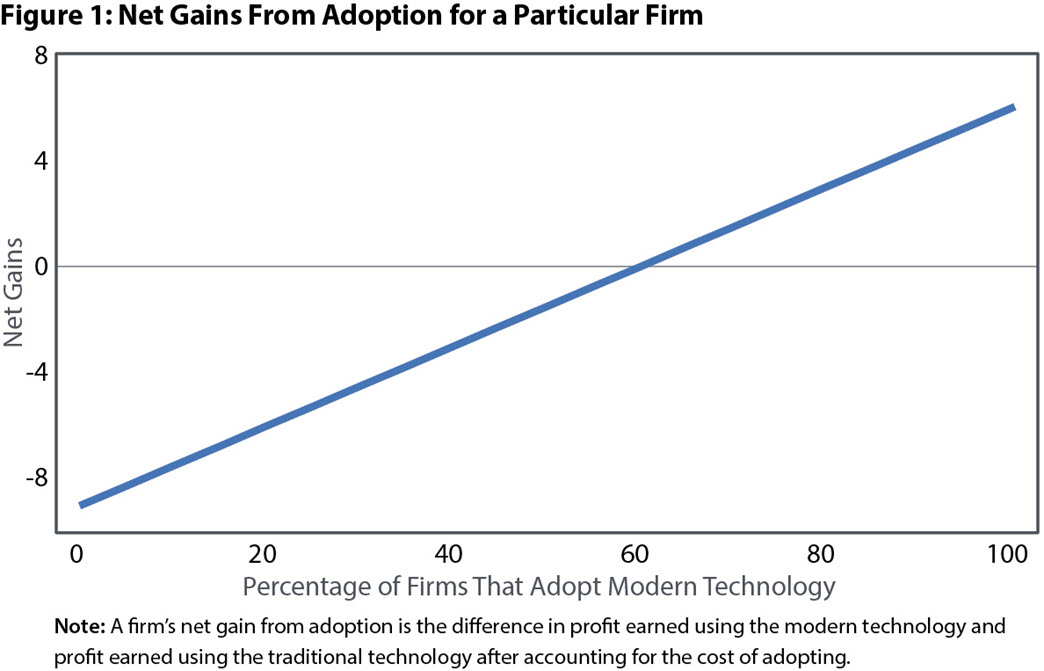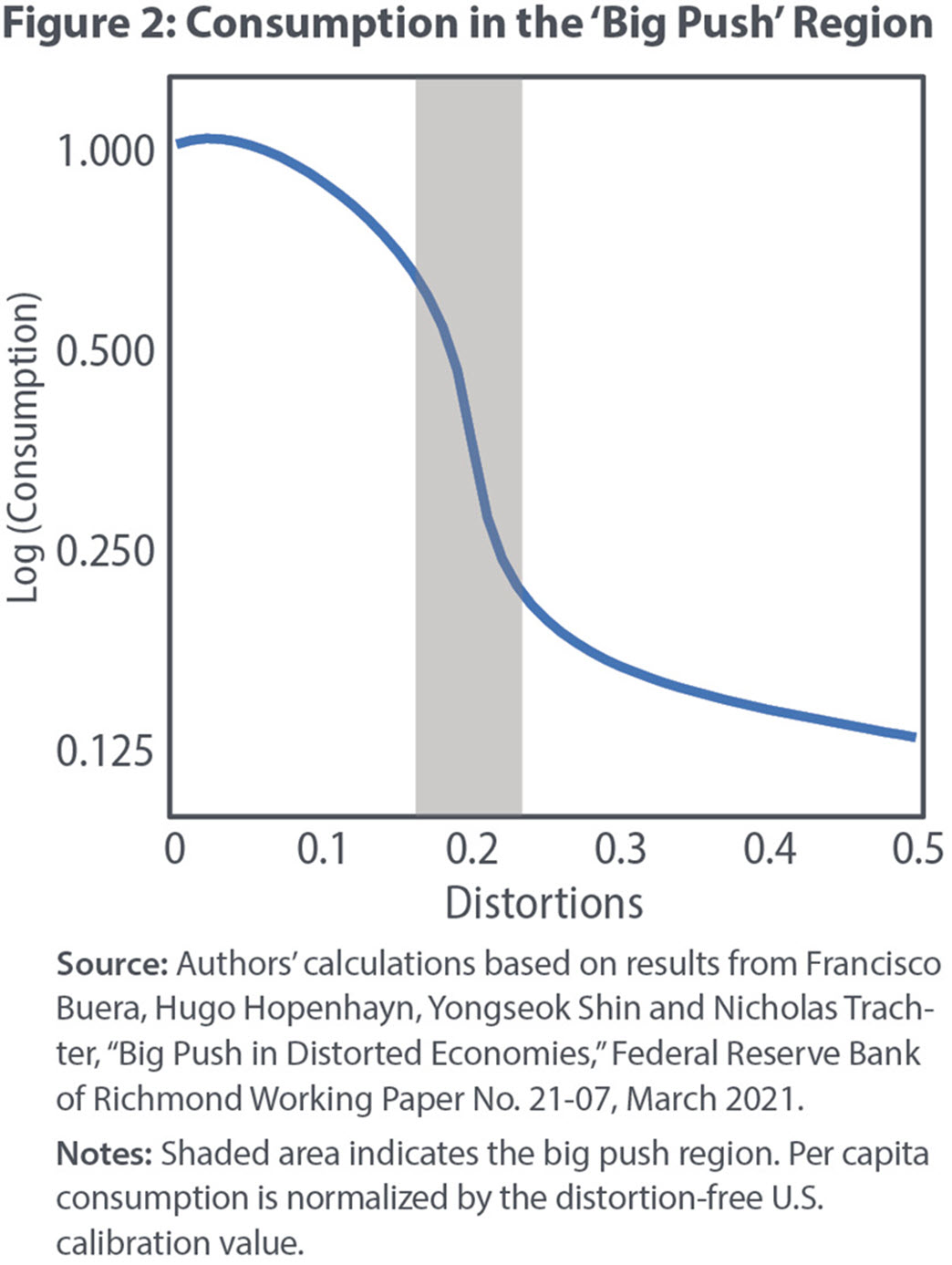Why Don't Low-Income Countries Adopt More Productive Technologies?
Researchers at UCLA, the Richmond Fed and Washington University in St. Louis have developed a theory of economic development in which complementarity in firms' technology-adoption decisions can substantially amplify the negative impacts of distortions in the economy and play an important role in explaining income differences across countries. By integrating theories that separately emphasize the roles of coordination failures and distortions, their unified framework shows that reducing distortions within "big push" regions could unleash massive economic growth.
Countries where firms regularly adopt highly productive technologies have experienced rapid economic growth, while countries where firms continue to use technologies that are less productive have remained poor. Previous research has considered two main theories to explain why firms in low-income countries have not adopted more productive technologies and achieved higher levels of economic development.1
The so-called "big push" paradigm of economic development has a long tradition among research economists.2 It assumes that a firm's gains from technology adoption depend substantially on the number of other firms that also adopt advanced technologies. In other words, the adoption decisions of the firms are complementary. In this theory, coordination of adoption decisions plays an important role in the modernization of a country's industry and its economic development. But while the gains from adoption may be large for any one firm when many other firms adopt, the cost of adoption may outweigh smaller gains when only a few firms adopt. In such a country, a big push to coordinate technology-adoption decisions could generate large gains in per capita income.
The more recent paradigm of economic development among research economists emphasizes the role of distortions (or barriers) to technology adoption. Distortions may include high taxes, monopoly power or a lack of contract enforcement.3 A problem with this theory is that models of economic development built solely on distortions require excessively large barriers to technology adoption in order to explain income differences across countries.
Researchers from UCLA, the Richmond Fed and Washington University in St. Louis integrate these two paradigms, providing a unified framework to study the forces that explain differences in per capita income across countries.4 They find that the interaction of coordination failures and distortions is crucial to understanding why some countries remain poor while others become rich. Specifically, when the level of distortions resides in a big push region — a range in which a firm's adoption decision is particularly sensitive to the adoption decisions of other firms — even a small reduction in distortions can substantially increase the level of per capita income in such a country.
The Model
The researchers develop a model in which firms have different levels of productivity and must pay an entry cost to operate in the market. Upon entry, a firm decides whether to operate using the traditional, low-productivity technology or the modern, high-productivity technology. Adopting the modern technology requires purchasing units of an adoption good, such as new equipment. These adoption goods, as well as the final goods sold to consumers, use goods produced by all firms in the economy as inputs of production.
A firm adopts the modern technology to produce greater quantities at a lower marginal cost. This expansion affects other firms in the economy in two basic ways. First, there is a negative competition effect: When the firm expands after adopting the modern technology, it takes business away from less productive firms. As a result, these other firms are less able to adopt the modern technology and expand. The strength of this competition effect is linked to the substitutability of goods produced by the different firms. When the goods are close substitutes, the competition effect is high. When the goods are weak substitutes, the competition effect is low. Second, a firm adopting the modern technology increases the demand for goods produced by other firms. This occurs because the firm requires more inputs to expand and because the adoption goods require inputs from all firms. Complementarities in adoption occur whenever the demand-inducing effect dominates the competition effect.
Complementarities, Coordination Failures and Amplification
Figure 1 shows a simple example of complementarity in firms' technology-adoption decisions. For a particular firm, the figure shows the net gains from adoption, given by the difference between the firm's profits using the modern versus traditional technologies as a function of the percentage of all firms that adopt. In this hypothetical case, net gains from adoption for the firm increase with the percentage of firms that adopt the modern technology, and thus the firm's adoption decision is complementary to the decisions of other firms.
When complementarities in adoption are strong enough, coordination failures may arise. While all firms might benefit from collectively adopting the modern technology, circumstances may dictate that no firm adopts the technology because no other firms are adopting and the gains from individually doing so would be negative. In other words, a lack of coordination among the firms suggests that there are multiple equilibria — multiple solutions to the economic model. One equilibrium has all firms adopting the modern technology, leading to high output and high consumption. Another equilibrium has all firms using the traditional technology, resulting in low output and low consumption.
The researchers show that complementarity in firms' technology-adoption decisions can arise as an amplification mechanism even without multiple equilibria. Amplification refers to the idea that the overall effect of a policy, or the effect of distortions, on technology adoption is stronger than the direct effect. In the paradigm of economic development built on distortions, there is typically no amplification because the overall effect of distortions is very close to the direct effect on an individual firm's adoption decision. However, in the unified framework featuring complementarity and distortions, the overall effect can be larger than the direct effect because a firm's adoption decision affects other firms' decisions.
Amplification and multiplicity of equilibria are closely related. To make the connection sharp, the researchers consider the hypothetical case of a small adoption subsidy and derive the necessary conditions for multiple equilibria and for amplification. Interestingly, the set of parameter values in the model that supports multiple equilibria is contained within the set of parameter values that supports amplification. In other words, complementarity can cause amplification without multiple equilibria. Therefore, the researchers suggest that the old paradigm of economic development — built on complementarity in firms' technology-adoption decisions — can explain large income differences across countries without relying on multiple equilibria.
Quantitative Analysis
The researchers use data on establishment-size distributions in the United States and India to calibrate the parameters of the model. They assume the United States is a distortion-free economy, and they use this assumption to estimate the degree of distortions in the Indian economy.
Several parameters are fixed outside of the model, while the remainder are chosen to match select empirical moments in the establishment-size distributions of the two countries. The calibrated model for the United States does not feature coordination failures — that is, the model has a unique equilibrium. In contrast, the calibrated model for India does feature multiple equilibria, although the calibration finds the economy to be in the high-adoption equilibrium.
The model generates a large income gap between the United States and India — similar to the gap found in the data. The identification of country-specific parameters relies only on the country's establishment-size distribution and does not use information on income or productivity. As a result, the model predicts an income gap due to model mechanisms rather than information from the data. Without directly using income levels in the two countries to inform the calibration, the model nonetheless accounts for approximately 90 percent of the cross-country income gap observed in the data.
Policy Implications of the Big Push Region
The model elements responsible for complementarity can amplify the effects of distortions with or without multiple equilibria, giving rise to a big push region where a firm's adoption decision is especially reactive to the decisions of other firms. To better understand this region, consider the calibration for the United States.
For a nontechnical summary of economic development theories, see Jessie Romero, "Why Aren't All Countries Rich?" Federal Reserve Bank of Richmond Econ Focus, Second Quarter 2011, vol. 15, no. 2, pp. 23–27.
See P. N. Rosenstein-Rodan, "Problems of Industrialisation of Eastern and South-Eastern Europe," The Economic Journal, June–September 1943, vol. 53, nos. 210–211, pp. 202–211.
For more on the monopoly power distortion, see Stephen L. Parente and Edward C. Prescott, "Monopoly Rights: A Barrier to Riches," American Economic Review, December 1999, vol. 89, no. 5, pp. 1216–1233.
See Francisco Buera, Hugo Hopenhayn, Yongseok Shin and Nicholas Trachter, "Big Push in Distorted Economies," Federal Reserve Bank of Richmond Working Paper No. 21-07, March 2021.
This article may be photocopied or reprinted in its entirety. Please credit the authors, source, and the Federal Reserve Bank of Richmond and include the italicized statement below.
Views expressed in this article are those of the authors and not necessarily those of the Federal Reserve Bank of Richmond or the Federal Reserve System.
Receive a notification when Economic Brief is posted online.



